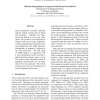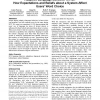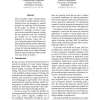64 search results - page 7 / 13 » Improving Word Alignment with Bridge Languages |
COLING
2000
13 years 8 months ago
2000
In the framework of statistical machine translation (SMT), correspondences between the words in the source and the target language are learned from bilingual corpora on the basis ...
NAACL
2007
13 years 9 months ago
2007
Letter-to-phoneme conversion generally requires aligned training data of letters and phonemes. Typically, the alignments are limited to one-to-one alignments. We present a novel t...
CHI
2006
ACM
14 years 8 months ago
2006
ACM
People display adaptive language behaviors in face-to-face conversations, but will computer users do the same during HCI? We report an experiment (N=20) demonstrating that users&#...
ACL
2006
13 years 9 months ago
2006
Given a parallel corpus, semantic projection attempts to transfer semantic role annotations from one language to another, typically by exploiting word alignments. In this paper, w...
EMNLP
2008
13 years 8 months ago
2008
One major bottleneck in conversational systems is their incapability in interpreting unexpected user language inputs such as out-ofvocabulary words. To overcome this problem, conv...



